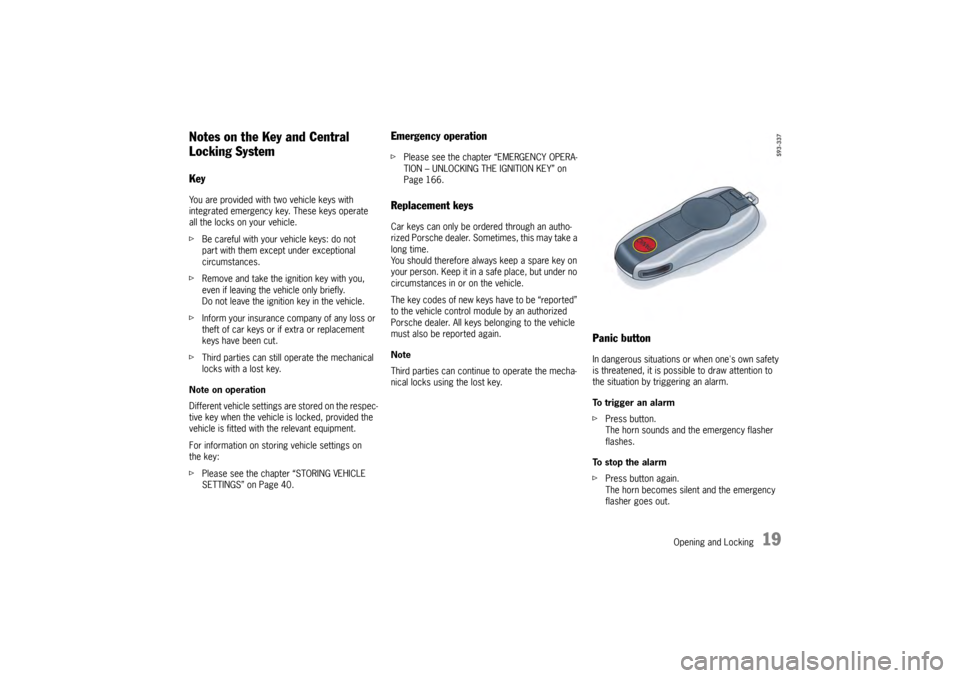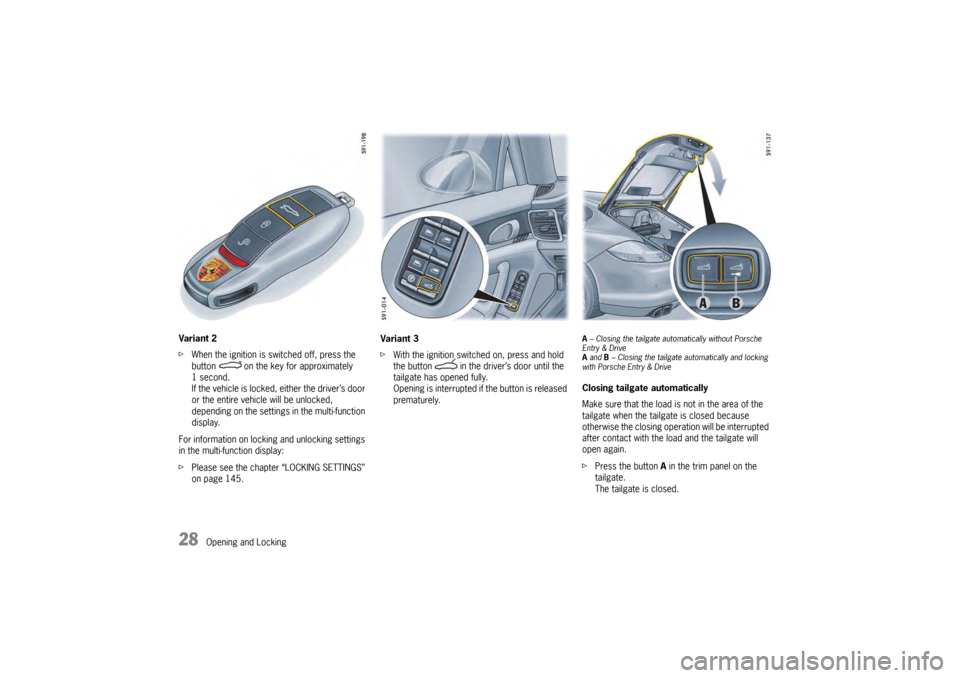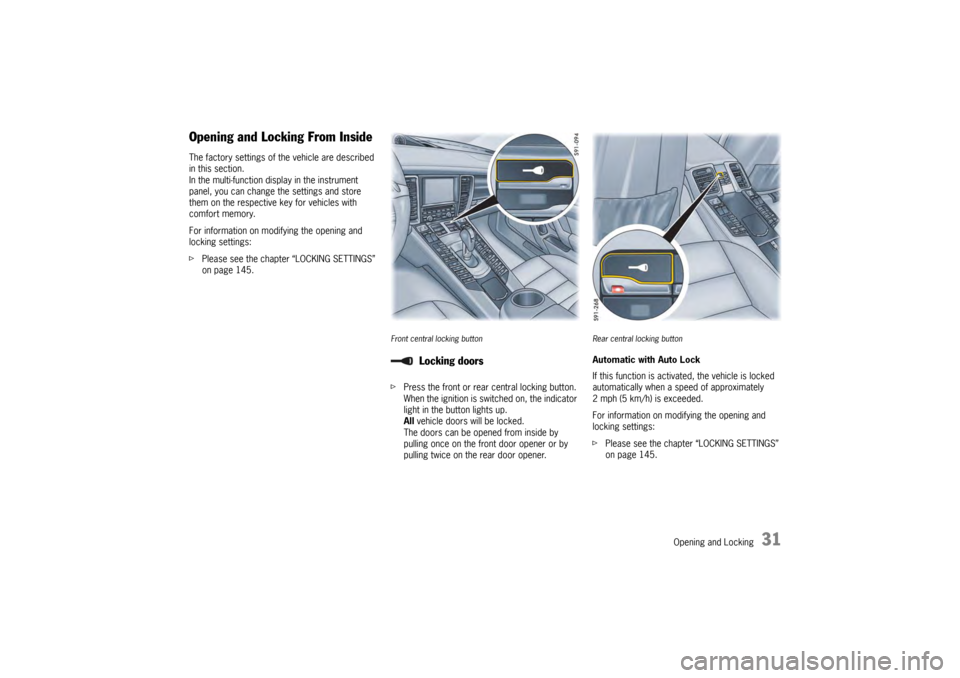2009 PORSCHE PANAMERA ignition
[x] Cancel search: ignitionPage 7 of 343

5
In the driver’s seat…fCheck operation of the horn.
f Position seat for easy reach of foot pedals and
controls.To reduce the po ssibility of injury from
the air bag deployment, you should always sit
back as far from the steering wheel as is
practical, while still maintaining full vehicle
control.
f Adjust the inside and outside rear view mirrors.
f Buckle your safety belts.
f Check operation of the foot and electric
parking brake.
f Check all warning and indicator lights with
ignition on and engine not running.
f Start engine and check all warning displays for
warning symbols.
f Never leave an idling car unattended.
f Lock doors from inside, especially with
children in the car to prevent inadvertent
opening of doors from inside or outside. Drive
with doors locked.
On the road…fNever drive after you have consumed alcohol
or drugs.
f Always have your safety belt fastened.
f Always drive defensively.
Expect the unexpected.
f Use signals to indicate turns and lane changes.
f Turn on headlights at dusk or when the driving
conditions warrant it.
f Always keep a safe distance from the vehicle in
front of you, depending on traffic, road and
weather conditions.
f Reduce speed at night and during inclement
weather.
Driving in wet weather requires caution and
reduced speeds, particularly on roads with
standing water, as the handling characteristics
of the vehicle may be impaired due to hydro-
planing of the tires.
f Always observe speed limits and obey road
signs and traffic laws.
f When tired, get well off the road, stop and take
a rest. Turn the engine off. Do not sit in the
vehicle with engine idling.
Please see the chapter “ENGINE EXHAUST” on
Page 2. f
When parked, always put the electric parking
brake on and put the PDK selector lever in
position P.
On hills also turn the front wheels toward the
curb.
f When emergency repairs become necessary,
move the vehicle well off the road. Turn on the
emergency flasher and use other warning
devices to alert other motorists. Do not park
or operate the vehicle in areas where the hot
exhaust system may come in contact with dry
grass, brush, spilled fuel or other flammable
material.
f Make it a habit to have the engine oil checked
with every refueling.
Page 10 of 343

8
Contents
Check Engine (Emission
Control) .................. 114
Acoustic Signals ......... ................................ 114
Operating the Multi-Function Display in the
Instrument Panel ......... ................................ 115
Vehicle Settings on the Multi-Function
Display........................................... ............ 138
Overview of Warning Messages.................... 152
Driving and Driving Safety ................ 163Ignition Lock, Steering Lock ........................ 164
Starting and Stopping the Engine ................. 167
Auto Start Stop Functi on ............................. 169
Electric Parking Brak e ................................. 171
Brakes .............. ......................... ................ 172
Cruise Control ................................ ............ 176
Adaptive Cruise Contr ol ............................... 178
Car Audio Operation/Ti ps ............................ 189
Porsche Communication Management
(PCM) ............................ ............................ 191
iPod
®, USB and AUX ....... ............................ 192
Voice Control.............. ................................ 192
Porsche Doppelkupplung (PDK) .................... 193
Selector-Lever Positions .................. ............ 195
Porsche Traction Management (PTM) ........... 202
Porsche Stability Management (PSM)............ 202
ABS Brake System (Anti-Lock Brake
System) ......................... ............................ 207
Porsche Active Suspension Management
(PASM)....................................................... 208
Porsche Active Suspension Management
(PASM) with Air Suspension and Level
Control ............. ......................... ................ 209
Porsche Dynamic Chassis Control (PDCC) .... 211
“Sport” and “Sport Plus ” Mode .................... 212 Sports Exhaust System
............................... 214
Retractable Rear Spoi ler .............................. 214
Storage, Luggage Compartment
and Roof Transport System .............. 217Storage........................ .............................. 218
Drinks Holder/Cuphold er ............................. 221
Front Ashtray ................ .............................. 224
Rear Ashtray...................................... ......... 224
Cigarette Lighter....... .................................. 225
Refrigerated box in the re ar of the vehicle..... 226
Folding Rear Seats Forward and Returning
to Upright Position ......................... ............. 226
Luggage Compartment. ............................... 227
Stowing Loads .............. .............................. 228
Luggage Compartment Cover ...................... 229
Fixed Luggage Compartm ent Cover ............. 231
Ski Bag ........................ .............................. 231
Roof Transport System ............................... 232
Loading Information .. .................................. 236Parking .................... ....................... 238ParkAssist ......................................... ......... 239
Rearview Camera ...... .................................. 241
Swivelling Down Mirror Glass as
Parking Aid ............... .................................. 242
Garage Door Opener . .................................. 243Alarm System and Theft
Protection ....................................... 246Alarm System and Passenger
Compartment Monitori ng ............................. 247
Immobilizer............... .................................. 250 Locking the Steering Column .......................250
Theft Protection ..........
................................250
Maintenance and Car Care ............... 251Exercise Extreme Caution when Working
on your vehicle ....... ....................................252
Engine Oil ........................................ ...........254
Checking Engine-Oil Le vel ............................254
Topping Up Engine Oi l ................................ 255
Checking Coolant Level and Adding
Coolant ........................... ...........................257
Brake Fluid ................. ................................258
Washer Fluid .............. ................................259
Power Steering .......... ................................260
Changing Air Cleaner ...................................261
Changing Particle Filt er ................................261
Wiper Blades .............. ................................261
Emission Control Syst em .............................262
How Emission Control Works .......................263
Fuel Economy ............. ................................264
Operating Your Porsche in other Countries ....264
Fuel ............................................ ...............265
Fuel Can ..................... ................................267
Fuel Recommendations ................................268
Fuel Evaporation Control .................. ...........269
Car Care Instructions ...................................269Minor Repairs .................................. 277Exercise Extreme Caution when Working
on your Vehicle ....... ....................................278
Tires and Wheels......... ................................280
Wheel Bolts ............... ................................293
Flat Tire...................... ................................293
Electrical System ........ ................................296
Page 13 of 343

Overview Illustrations
11
Driver’s Cockpit1. Door openerSee page 32.
2. Vehicle setting memory buttons See page 40.
3. Electric parking brake See page 171.
4. Steering wheel adjustment See page 62.
5. Overhead operating console See page 15.
6. Power windows See page 86.
7. Exterior-mirror setting See page 58.
8. Engine compartment lid release See page 33.
9. Diagnostic socket (OBD)
10.Light switch See page 92.
11.Ignition lock, steering lock See page 164.
12.Dimming of instrument lighting See page 95.
13.Seat adjustment See page 39.
Page 20 of 343

18
Opening and Locking
Never invite car theft!An unlocked car with the key in the ignition lock
invites car theft.
A steering wheel lock and a gong alarm are
standard equipment in your Porsche. The gong
alarm will sound if you open the driver's door while
the key is still in the ignition lock. It is your
reminder to pull the key out of the ignition lock and
to lock the doors.
Warning!
Any uncontrolled movement of the vehicle
may result in property damage, serious
personal injury or death.
Never leave your vehicle unattended with the
key in the ignition lock, especially if children
and/or pets are left unattended in the
vehicle. They can operate power windows
and other controls. If the engine is left
running, they may accidentally engage the
shift lever. Serious personal injury or death
could result from loss of control of the
vehicle.
f Always remove the ignition key.
f Always set the electric parking brake.
f Lock the doors with the key or with the remote control.
Warning!
Risk of a serious accident.
The steering column will lock when you
remove the key while you are driving or as
the car is rolling to a stop. You will not be
able to steer the car.
Serious personal injury or death could result
from loss of control of the vehicle.
f Never remove the key from the steering lock while you are driving. To protect your vehicle and your possessions
from theft, you should always proceed as
follows when leaving your vehicle:
f
Close windows.
f Close slide/tilt roof.
f Remove ignition key (switch ignition off in
vehicles that have Porsche Entry & Drive).
f Engage steering lock.
f Remove valuables (e.g. car documents, radio
control module, cell phones, house keys) from
the car.
f Lock doors.
f Lock the glove compartment.
f Close storage trays.
f Cover luggage compartment with the luggage
compartment cover.
f Close rear lid.
Page 21 of 343

Opening and Locking
19
Notes on the Key and Central
Locking System KeyYou are provided with two vehicle keys with
integrated emergency key. These keys operate
all the locks on your vehicle.
fBe careful with your vehicle keys: do not
part with them except under exceptional
circumstances.
f Remove and take the ignition key with you,
even if leaving the vehicle only briefly.
Do not leave the ignition key in the vehicle.
f Inform your insurance company of any loss or
theft of car keys or if extra or replacement
keys have been cut.
f Third parties can still operate the mechanical
locks with a lost key.
Note on operation
Different vehicle settings are stored on the respec-
tive key when the vehicle is locked, provided the
vehicle is fitted with the relevant equipment.
For information on storing vehicle settings on
the key:
f Please see the chapter “STORING VEHICLE
SETTINGS” on Page 40.
Emergency operationfPlease see the chapter “EMERGENCY OPERA-
TION – UNLOCKING THE IGNITION KEY” on
Page 166.Replacement keysCar keys can only be ordered through an autho-
rized Porsche dealer. Sometimes, this may take a
long time.
You should therefore always keep a spare key on
your person. Keep it in a safe place, but under no
circumstances in or on the vehicle.
The key codes of new keys have to be “reported”
to the vehicle control mo dule by an authorized
Porsche dealer. All keys belonging to the vehicle
must also be reported again.
Note
Third parties can continue to operate the mecha-
nical locks using the lost key.
Panic buttonIn dangerous situations or when one's own safety
is threatened, it is possible to draw attention to
the situation by triggering an alarm.
To trigger an alarm
f Press button.
The horn sounds and the emergency flasher
flashes.
To stop the alarm
f Press button again.
The horn becomes silent and the emergency
flasher goes out.
Page 30 of 343

28
Opening and Locking
Variant 2
f
When the ignition is switched off, press the
button on the key for approximately
1second.
If the vehicle is locked, either the driver’s door
or the entire vehicle will be unlocked,
depending on the settings in the multi-function
display.
For information on locking and unlocking settings
in the multi-function display:
f Please see the chapter “LOCKING SETTINGS”
on page 145. Variant 3
f
With the ignition switched on, press and hold
the button in the driver’s door until the
tailgate has opened fully.
Opening is interrupted if the button is released
prematurely.
A – Closing the tailgate auto matically without Porsche
Entry & Drive
A and B – Closing the tailgate au tomatically and locking
with Porsche Entry & DriveClosing tailgate automatically
Make sure that the load is not in the area of the
tailgate when the tailgate is closed because
otherwise the closing operation will be interrupted
after contact with the load and the tailgate will
open again.
f Press the button A in the trim panel on the
tailgate.
The tailgate is closed.
Page 33 of 343

Opening and Locking
31
Opening and Locking From InsideThe factory settings of the vehicle are described
in this section.
In the multi-function display in the instrument
panel, you can change the settings and store
them on the respective key for vehicles with
comfort memory.
For information on modifying the opening and
locking settings:
fPlease see the chapter “LOCKING SETTINGS”
on page 145.
Front central locking buttonfPress the front or rear central locking button.
When the ignition is switched on, the indicator
light in the button lights up.
All vehicle doors will be locked.
The doors can be opened from inside by
pulling once on the front door opener or by
pulling twice on the rear door opener.
Rear central locking buttonAutomatic with Auto Lock
If this function is activate d, the vehicle is locked
automatically when a speed of approximately
2 mph (5 km/h) is exceeded.
For information on modifying the opening and
locking settings:
f Please see the chapter “LOCKING SETTINGS”
on page 145.
Locking doors
Page 34 of 343

32
Opening and Locking
f
Press the front or rear central locking button.
The indicator light on the button goes out.
All vehicle doors will be unlocked.
Automatic with Auto Unlock
The vehicle is automatically unlocked when the
ignition key is removed.
Note on operation
If the vehicle was locked by remote control or with
the key, it cannot be unlocked with the central
locking button.
Opening doorsOpening unlocked doors
f Pull door opener ( arrow) once.
Opening locked doors
f Pull once on the front door opener ( arrow) or
twice on the rear door opener.
Securing rear doorsYou can prevent passenge rs from accidentally
pulling the door opener and opening the rear
doors from inside.
Unlocking doors